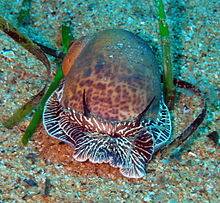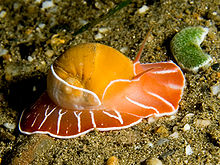- Naticidae
-
Naticidae
Temporal range: late Triassic or early Jurassic - Recent[1]
Naticarius hebraeus (Martyn, 1786) Scientific classification Kingdom: Animalia Phylum: Mollusca Class: Gastropoda (unranked): clade Caenogastropoda
clade Hypsogastropoda
clade LittorinimorphaSuperfamily: Naticoidea
Guilding, 1834Family: Naticidae
Guilding, 1834Diversity 260-270 Recent species[1] Naticidae, common name the moon snails, is a family of minute to large-sized predatory sea snails, marine gastropod molluscs in the clade Littorinimorpha.
Naticidae is the only family in the superfamily Naticoidea.
It has been estimated that worldwide there are about 260–270 Recent species of naticid snails.[1] This group is assumed to have originated in the late Triassic or in the early Jurassic.[1] Members of this family can be recognized by the shape of their shells, distinct appearance or by their predatory behavior.[1]
Contents
Distribution
Naticids are widely distributed and occur world-wide. The greatest diversity of both species and genera is found in tropical regions. Even so, naticid snails are also plentiful in temperate, Arctic and Antarctic waters.[1]
Habitat
Moon snails live on sandy substrates, at a great variety of depths depending on the species (from the intertidal zone to thousands of meters in depth).[1] They are often seen ploughing along in the sand searching for prey.
Life habits
50 second video of snails (most likely Natica chemnitzi and Cerithium muscarum) feeding on the sea floor in the Sea of Cortez, Puerto Peñasco, Mexico
Naticids are predatory, feeding mostly on bivalves. They will also attack almost any other shelled mollusk they encounter in the sand, such as scaphopods and other gastropods, including other moon snails.[1] Additionally, Conuber sordidus was shown to prey on the soldier crab Mictyris longicarpus (Crustacea) by drilling predation.[2][3] To catch soldier crabs, C. sordidus uses the same stereotyped behaviour as previously described for moon snails hunting shelled molluscan prey.[3]
The moonsnail envelops the prey and then bores a hole through the shell using their radula and an acid secretion. Once the shell is bored open, the proboscis is used to consume the flesh of the prey. The hole in the shell, which has a "countersunk" appearance with chamfered edges and which varies in size according to the species, is a characteristic diagnostic sign of moon snail predation.
In the breeding season, the female moon snail lays a rather stiff egg mass which includes sand and mucus. These objects wash up on sandy beaches fairly often, and are known by the common name "sand collars" because of their resemblance to an old-fashioned removable shirt collar or false-collar.
Taxonomy
Traditional classification
Some authors have suggested a distinct separation of the Naticidae into four subfamilies: Ampullospirinae, Naticinae, Polinicinae and Sininae.[4] This arrangement is mainly based on morphological data, such as details of the operculum including the material (calcareous in the Naticinae, corneous in the Polinicinae and Sininae) and size, and also the morphology of the shell.[5][6][7]
2005 taxonomy
The following three subfamilies were recognized in the taxonomy of Bouchet & Rocroi (2005):[8]
- Naticinae Guilding, 1834 - synonyms: Polinicinae Gray, 1847; Neveritinae Gray, 1857; Choristidae Verrill, 1882; Euspiridae Cossmann, 1907; Mammillinae Iredale & McMichael, 1962; Eunaticinini Oyama, 1469
- Sininae Woodring, 1928 - synonyms: Sigaretidae Gary, 1827; Cryptostomidae Gray, 1827
- Globisininae Powell, 1933
Genera
Genera in the family Naticidae include:
subfamily Naticinae
- Eunaticina Fischer, 1885
- Euspira Agassiz in Sowerby, 1838
- Natica Scopoli, 1777
- Neverita Risso, 1826 - its subgenus or synonym includes Glossaulax Pilsbry, 1929 [6][9]
- Polinices Montfort, 1810
subfamily Sininae
- Sinum Röding, 1798
subfamily Globisininae
- Globisinum Marwick, 1924
subfamily ?
- Acrybia Adams, 1853
- Amauropsis Mörch, 1857
- Bulbus Brown, 1839
- Calinaticina J. Q. Burch & Campbell, 1963
- Conuber Finlay & Marwick, 1937
- Cryptonatica Dall, 1892
- Falsilunatia Powell, 1951
- Friginatica Hedley, 1916
- Gyrodes Conrad, 1860
- Haliotinella Souverbie, 1875
- Lunatia Gray, 1847
- Naticarius Duméril, 1806
- Proxiuber Powell, 1933
- Sigatica Meyer and Aldrich, 1886
- Spironema Meek, 1864[10]
- Stigmaulax Mörch, 1852
- Tanea Marwick, 1931
- Tasmatica Finlay & Marwick, 1937
- Tectonatica Sacco, 1890
- Uberella Finlay, 1928
References
- ^ a b c d e f g h Huelsken, T.; Marek, C; Schreiber, S; Schmidt, I; Hollmann, M. (2008). "The Naticidae (Mollusca: Gastropoda) of Giglio Island (Tuscany, Italy): Shell characters, live animals, and a molecular analysis of egg masses". Zootaxa (Magnolia Press) 1770: 1–40. ISSN 1175-5334. http://www.mapress.com/zootaxa/2008/f/zt01770p040.pdf. Retrieved 7 June 2010.
- ^ Ann M. Cameron (1966). "Some aspects of the behaviour of the soldier crab, Mictyris longicarpus". Pacific Science 20 (2): 224–234. hdl:10125/7754.
- ^ a b Huelsken, T. (2011) First evidence of drilling predation by Conuber sordidus (Swainson, 1821) (Gastropoda: Naticidae) on soldier crabs (Crustacea: Mictyridae). Molluscan Research, 31(2), 125-131. [1]
- ^ Kabat A.R. 1991. The classification of the Naticidae (Mollusca: Gastropoda): Review and analysis of the supraspecific taxa. Bull. Mus. Comp. Zool., 152, 417-449.
- ^ Cernohorsky W.O. 1971. The family Naticidae (Mollusca: Gastropoda) in the Fiji Islands. Auckland Inst. Mus., 8, 169-208.
- ^ a b Marincovich L.N. 1977. Cenozoic Naticidae (Mollusca: Gastropoda) of the Northeastern Pacific. Bulletins of American Paleontology, 70, 169-212.
- ^ Bandel K. 1999. On the origin of the carnivorous gastropod group Naticoidea (Mollusca) in the Cretaceous with description of some convergent but unrelated groups. Greifswalder Geowissenschaftliche Beiträge, 6, 134-175.
- ^ Bouchet P., Rocroi J.-P., Frýda J., Hausdorf B., Ponder W., Valdés Á. & Warén A. (2005). "Classification and nomenclator of gastropod families". Malacologia: International Journal of Malacology (Hackenheim, Germany: ConchBooks) 47 (1-2): 1–397. ISBN 3925919724. ISSN 0076-2997. http://www.archive.org/details/malacologia47122005inst.
- ^ Majima, R. 1989. Cenozoic fossil Naticidae (Mollusca: Gastropoda) in Japan. Bulletin of American Paleontology, 96 (331), 1-159.
- ^ Siemers C. T. & King N. R. (1974). "Macroinvertebrate paleoecology of a transgressive marine sandstone, Cliff House Sandstone (Upper Creteceous), Chaco Canyon, northwestern New Mexico" PDF.
Further reading
- Powell A. W. B. 1979. New Zealand Mollusca, William Collins Publishers Ltd, Auckland, New Zealand ISBN 0-00-216906-1
- Ponder W. & Lindberg D. 1997. Towards a phylogeny of gastropod molluscs; an analysis using morphological characters. Zoological Journal of the Linnean Society, 119: 83-265, London, ISSN 0024-4082.
- Aronowsky A. (2003). "Mystery of naticid predation history solved: Evidence from a "living fossil" species: COMMENT". pp E34. Geological Society of America- online. http://www.gsajournals.org/perlserv/?request=get-static&name=i0091-7613-31-6-e34&ct=1. Retrieved 2008-06-14.
- Huelsken T. et al. 2006. Neverita delessertiana (Recluz in Chenu, 1843): a naticid species (Gastropoda: Caenogastropoda) distinct from Neverita duplicata (Say, 1822) based on molecular data, morphological characters, and geographical distribution. Zootaxa, 1257:1-25.
- Colgan D.J. et al. 2007. Molecular phylogenetics of Caenogastropoda (Gastropoda: Mollusca). Molecular Phylogenetics and Evolution, 42, 717-37.
External links
- CLEMAM - Taxonomic Database on European Marine Mollusca of the Muséum National d'Histoire Naturelle and the Department of Systematics & Evolution, Paris.
- The Naticidae of Giglio Island at Morphobank - Homology of phenotypes over the web
- Malacolog 4.1.0 - A Database of Western Atlantic Marine Mollusca
- "Naticidae". Integrated Taxonomic Information System. http://www.itis.gov/servlet/SingleRpt/SingleRpt?search_topic=TSN&search_value=72878.
- Naturamediterraneo - Mediterranean fauna and flora
- Publications and sequences of the Naticidae submitted to the NCBI
Categories:
Wikimedia Foundation. 2010.

